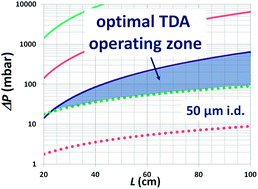On the optimization of operating conditions for Taylor dispersion analysis of mixtures
Abstract
In this work, we investigate the possibility of optimizing the operating conditions, namely mobilizing pressure, capillary length and capillary radius, for performing Taylor dispersion analysis on solutes having hydrodynamic diameter, 2Rh, between 1 and 100 nm. Optimizing Taylor dispersion analysis means finding the set of operating conditions that verify the conditions of validity of this method, and finding the most appropriate conditions that may enhance or maximize the separation performances. Our conclusion is that the performances of Taylor dispersion analysis are independent of the operating conditions, as far as the conditions of validity of the method are verified. The inequalities defining the set of acceptable operating conditions are given in this work as a function of the maximal relative error on the diffusion coefficient, D, fixed by the user. These inequalities define operating zones that were represented for three typical capillary diameters (25, 50 and 100 μm). Within these zones, all experiments should lead to similar results on D (or Rh) and similar separation performances. It was concluded that assuming a 3% relative error on the determination of D, a 60 cm × 50 μm i.d. capillary can be used by default for performing TDA of analytes in the 1–100 nm diameter range with mobilizing pressure in the 50–100 mbar range.


 Please wait while we load your content...
Please wait while we load your content...